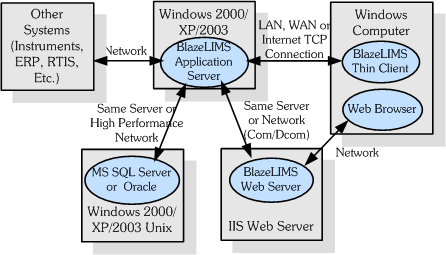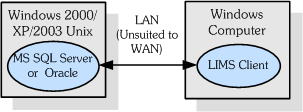BlazeLIMS is implemented as a thin client application, in which its client communicates with the BlazeLIMS Application Server, where the most significant elements of its business logic are implemented. Its SQL Server or Oracle database may be located on the same server or accessed by the high-performance network on another closely coupled server. Because of its thin client architecture, BlazeLIMS is:
- Robust -Because it runs in a controlled and structured server environment, tightly coupled to the database, the application is not prone to lockups and other failures caused by the foibles of the desktop environment.
- Scaleable -Can run hundreds of concurrent users with properly resource server.
- Suitable for Wide Area Networking – Low network loading and other implementation factors ensure that BlazeLIMS operates well over wide area networks without the use of expensive terminal services software. This performance has been demonstrated on installations with 100+ users distributed over thousands of miles.
- Maintainable – All application elements (screens, reports, business logic, etc.) are maintained on the server, not the desktop, for ease of maintenance, backup, access control, minimum redundancy, etc. Even the thin client software can be configured to automatically download itself when software upgrades require it.
- Enterprise Ready – Application server ideally suited for integration with other enterprise systems, instruments, running unattended tasks (e.g. routine report production and distribution), etc.

BlazeLIMS is offered with two client flavors:
- Windows thin client with a richer and more powerful user interface features available in windows, suitable for routine or power user.
- Web browser client with a more restricted user interface associated with HTML based operation.
The LIMS purchaser should be wary of 2-tier client server LIMS implementations where the desktop client communicates directly with the database, and where the main business logic resides on the client. Although this architecture is quite common among LIMS suppliers and is less expensive to develop, it is inherently prone to lockups, difficulties in scaling and maintainability problems, and is not suitable for WAN use without expensive terminal services software.
